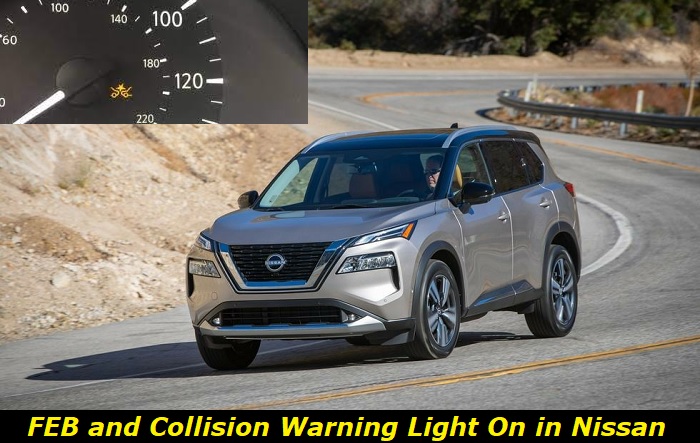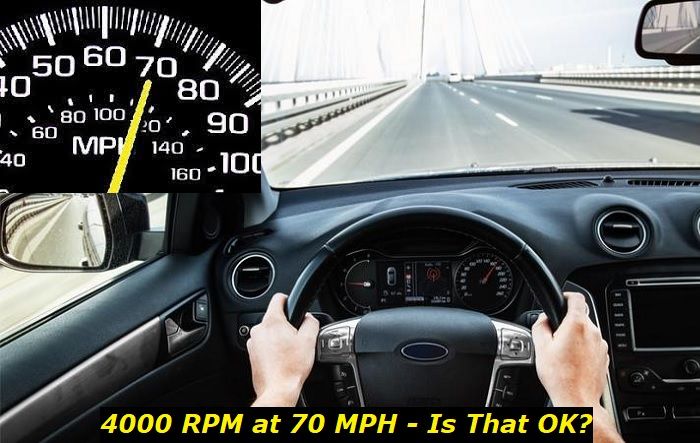The Forward Emergency Braking (FEB) System in Nissan is a collision warning system designed to help reduce the risk of an accident. The system works by detecting objects that are close or at a distance from the vehicle and providing an audible alert if it believes an imminent crash is likely.
FEB and Collision warning light highlights
- Common reasons:radar blocked, software issues, radar broken
- How to fix:clean the radar area, disconnect the battery for some time
- Possible consequences:smart functions won't work
- Priority level:Low
- Can you drive?Yes
- DIY repair:Possible
- Repair price range:$0-$550

How the Forward Emergency Braking and the Collision Warning Light Work
Once the Forward Emergency Braking has detected an object through its sensors, it will provide warning signals such as a Collision Warning light on the dashboard and audio alerts. Additional measures may be taken when a crash appears imminent like the application of the brakes automatically if needed.
The Forward Emergency Braking provides an added layer of safety when driving, but it is still important to be aware of your surroundings and take appropriate action whenever a warning signal is displayed. In the event that the FEB experiences technical malfunctions, the system may fail to detect objects or provide alerts in time for you to react safely.
As a result, a crash could occur that would not have happened had the system been functioning correctly. There is also a chance that false warnings could pop out which can lead to unnecessary braking maneuvers that the driver may do or that the car itself may apply automatically. These scenarios can cause confusion and even put drivers and other vehicles at risk.
It's important to note that many Nissan vehicles are equipped with other collision avoidance systems such as Blind Spot Warning and Rear Cross Traffic Alerts. These systems can help drivers stay aware of their surroundings and provide additional warnings when needed to prevent crashes. All these complement the Forward Emergency Braking in some ways.
Likewise, regular maintenance should be done on FEB-equipped vehicles in order to ensure that the system is functioning properly at all times. Doing so will greatly minimize your risk of being involved in a crash due to technical malfunctions.
Most Common Causes of the Problem
Rummaging over owner complaints, reports, official documents of Nissan, forums, and other sources, we found out that the most common causes and solutions to the false alarm regarding the Forward Emergency Braking System in Nissan coupled with the activation of the Collision Warning light are the following:
1. Dirt or Moisture Build-Up on the Sensors
Most reports state that inclement weather conditions usually trigger these specific issues with the Forward Emergency Braking System together with the Collision Warning light in Nissan. These situations usually lead to obstructions on the sensors, such as the build-up of moisture, dirt, and debris.
In turn, these elements can interfere with the sensors' ability to detect an object in front of the vehicle. They are normally the culprits behind the false activation of the auto's precautionary measures against a potential collision.
To assess the source of the problem, it is important to look for certain symptoms first. It is essential that a thorough visual inspection of all sensor components, particularly those located in front of the car, be conducted and any obstructions should be identified and cleared right away.
Once this is done, it is also recommended that manual checks be performed by inspecting possible loose or corroded connections and confirming the proper mounting of all parts concerned with the sensors. Furthermore, using a diagnostic tool will help verify if there are any faults present within these systems as a result of the situation.
The key solution to a mere obstructed sensor normally involves cleaning the affected lens with a soft cloth. Sometimes, it may be necessary to dab the cloth in a lens cleaning solution to take care of hard-to-remove dirt or corrosion blocking the coverage of the sensor.
However, if you have found out that corrosion has already eaten up parts of the sensor, that's a sign that you should replace it as soon as possible.
2. Damaged Sensors
A damaged sensor can also produce more problems that could lead to the activation of the Forward Emergency Braking System alert and the Collision Warning light in Nissan. This could produce the same effects exhibited by an obstructed sensor, and sometimes even more if such an issue is an offshoot of other electrical problems.
This is why it is essential to do visual inspections for signs of these without procrastinating. Also, scanning each sensor using a diagnostic tool can reveal more about the specific problem.
If you notice corrosion or any signs of damage wearing down the sensor's components, that's an indication that the sensor assembly needs to be replaced as soon as possible. If left ignored, this can lead to further damage to other parts affected by the sensors which may cost more time and money to fix.
It is important to note as well that replacing the sensors should be made with genuine/original parts from Nissan only since a lot of after-market products may not always be compatible with what you have or it may not guarantee sufficient protection against the elements of harsh conditions.
Ultimately, the proper maintenance of these sensors should be observed in order to prevent any further problems with the Forward Emergency Braking System together with the associated Collision Warning light.
3. Wiring Issues
Wiring issues can often be the root cause of Forward Emergency Braking System and Collision Warning light problems in Nissan cars. The most common causes of these wiring problems include corrosion, abrasion, and short circuits due to loose connections or damaged insulation.
These may also be the results of poor electrical component installation methods, contact with chemical agents, or harsh environmental conditions capable of corroding parts.
To detect possible wiring issues, one must first recognize their associated symptoms. These can range from a sudden decrease in engine performance and/or fuel economy to sluggish acceleration, difficulty starting, flickering lights, and malfunctioning electrical equipment in the car.
Visual checks should also be conducted to assess any damage that may have occurred on the wires, especially the ones going to the connectors of the switches, sensors, and onboard modules of the vehicle. Likewise, a diagnostic tool such as a multimeter can be utilized to identify any open or short circuits in the wiring system.
Solving the issue commonly requires replacing the affected parts and/or wires. This includes inspecting for signs of broken, corroded, or abraded insulation on the cables. If needed, one may have to disassemble certain components and connectors to access any exposed wiring that needs replacement, too.
To avoid damaging other components within the car's electrical system, it is important to exercise caution while disconnecting and re-connecting these pieces. Once all faulty parts are replaced with functional ones, a test should be conducted to make sure that both the Forward Emergency Braking System and the Collision Warning light are working as they should. If the issue persists, further diagnosis may be necessary.
4. ECU Malfunction
The electronic control unit (ECU) monitors and manages the vehicle's engine, transmission, and electrical components. When an ECU malfunctions, it can cause several issues that can lead to the false activation of the Forward Emergency Braking System along with the Collision Warning light in Nissan vehicles.
The common causes of ECU malfunction can include improper wiring, faulty sensors or actuators, faulty internal circuitry, or glitched software.
To detect the problem, one should first recognize the symptoms. This may include poor acceleration and jerky transmission shifts due to incorrect readings from the relevant sensors. Additionally, visual checks such as inspecting the wiring for faults might be necessary in order to identify any loose connections or corroded terminals.
Furthermore, tools such as oscilloscopes or multimeters might be used for testing the individual components responsible for the general operation of the ECU.
The solution to this problem may involve replacing some of the affected parts. These could include the relevant sensors, actuators, or wiring terminals if any faults are detected. Moreover, if faulty internal circuitry is identified, it might be necessary to replace the entire ECU unit itself to restore normal functioning.
However, there may be times when the trouble you are experiencing is only due to software glitches on the system of your auto. In this case, reflashing the ECU may be necessary to patch up its software to the recommended settings of Nissan.
Although there are kits or tools sold out there that will allow you to reflash your vehicle on your own, it's always best to have the work done professionally by an experienced mechanic or thru a service center authorized by your carmaker.
Conclusion
The Forward Emergency Braking and the Collision Warning Light together with other driving assistance features make Nissan vehicles safer for drivers and passengers alike, helping them arrive safely at their destination every time they get behind the wheel.
By understanding how these technologies work, taking proper precautions when driving, and knowing how to troubleshoot their potential issues, you can be rest assured knowing that you're doing your part to keep yourself and those around you safe at all times.
About the authors
The CarAraC research team is composed of seasoned auto mechanics and automotive industry professionals, including individuals with advanced degrees and certifications in their field. Our team members boast prestigious credentials, reflecting their extensive knowledge and skills. These qualifications include: IMI: Institute of the Motor Industry, ASE-Certified Master Automobile Technicians; Coventry University, Graduate of MA in Automotive Journalism; Politecnico di Torino, Italy, MS Automotive Engineering; Ss. Cyril and Methodius University in Skopje, Mechanical University in Skopje; TOC Automotive College; DHA Suffa University, Department of Mechanical Engineering






Add comment